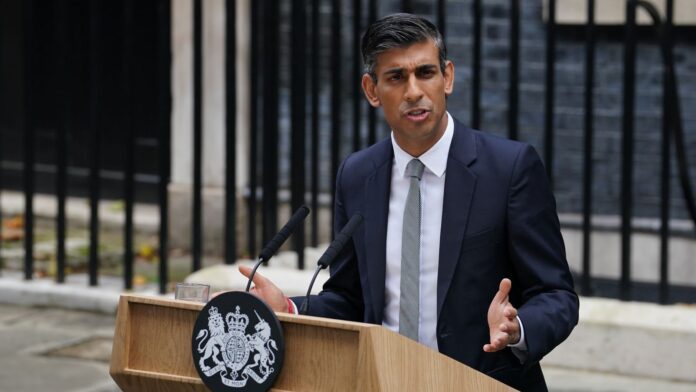The UK’s economic landscape is poised for a potential shift as Chancellor Rishi Sunak hints at business tax cuts to stimulate economic growth. In a speech on Monday, the prime minister emphasized a careful and sustainable reduction of the tax burden, leaving the specifics for the upcoming autumn statement. This move, focusing on the “supply side” of the economy, raises questions about the potential impact on businesses and the broader economic agenda.
A Vision for Economic Transformation
The Balance Between Big Government and Private Sector Dynamism
Sunak outlined a choice between a “big government” approach, characterized by high spending and taxes – deemed necessary in recent years – and a shift toward growing the economy through the dynamism of the private sector. With inflation halved, the government is gearing up to make five long-term decisions to shape the next phase of the economic plan.
Five Key Economic Priorities
- Reducing Debt: A commitment to managing and reducing the national debt, signaling a move toward fiscal responsibility.
- Cutting Tax and Rewarding Hard Work: A promise to cut taxes carefully and sustainably, with an emphasis on rewarding hard work to spur economic activity.
- Building Domestic and Sustainable Energy: Recognition of the importance of investing in domestic and sustainable energy sources for long-term economic stability.
- Backing British Business: A focus on supporting and promoting the growth of British businesses to drive economic prosperity.
- Delivering World-Class Education: Acknowledgment of the critical role of education in shaping a skilled and competitive workforce.
Tax Cuts on the Horizon
The prospect of tax cuts looms prominently on the economic horizon as Chancellor Rishi Sunak signals a strategic move to stimulate growth and reshape the fiscal landscape. This section delves into the nuances of the proposed tax cuts, examining the underlying motives, potential implications, and the broader economic strategy behind this pivotal decision.
1. Strategic Stimulus for Economic Growth
The core rationale behind the contemplated tax cuts lies in their role as a strategic stimulus for economic growth. By reducing the tax burden on businesses and individuals, the government aims to inject liquidity into the economy, fostering increased spending, investment, and overall economic activity. This approach aligns with supply-side economic theory, emphasizing the importance of empowering businesses to drive economic expansion.
2. Balancing Fiscal Responsibility and Stimulus
Sunak’s emphasis on a “serious, responsible” approach to tax cuts underscores the government’s commitment to maintaining fiscal responsibility while actively seeking to stimulate economic recovery. Striking the right balance is crucial, as tax cuts must be carefully calibrated to avoid compromising long-term fiscal health. This nuanced strategy reflects a recognition of the need for both short-term economic relief and sustained financial stability.
3. Adherence to Fiscal Rules and Independent Oversight
The commitment to adhere to fiscal rules and consider the independent forecasts of the Office for Budget Responsibility adds a layer of transparency and accountability to the proposed tax cuts. Sunak’s pledge to align with established guidelines ensures that the economic strategy remains within the bounds of responsible financial management. Independent oversight provides a checks-and-balances mechanism, instilling confidence in the public and financial markets.
4. Prioritization and Phased Implementation
Sunak acknowledges the need for a phased and prioritized approach to tax cuts. The recognition that “we can’t do everything all at once” emphasizes the importance of sequencing and prioritizing tax reductions based on their potential impact and the prevailing economic conditions. This strategic sequencing allows for a more targeted and effective implementation of tax relief measures.
5. Stimulating Business Investment and Competitiveness
Business tax cuts, hinted at by Sunak, aim to stimulate investment, enhance competitiveness, and create a favorable environment for entrepreneurial activities. By reducing the corporate tax burden, the government seeks to incentivize businesses to expand, innovate, and contribute to job creation. This aligns with the broader goal of supporting British businesses as a driving force behind economic resurgence.
Welfare System Sustainability
Compassionate, Fair, and Sustainable
When questioned about a potential squeeze on welfare payments, Sunak highlighted the unsustainability of the current welfare system. He emphasized the government’s commitment to a compassionate, fair, and sustainable welfare system while addressing the challenges posed by a large population of working-age individuals currently not employed.
A Balanced Approach
Sunak’s comments suggest a potential reevaluation of welfare policies, balancing compassion with fiscal responsibility. The government’s aim is to address inefficiencies in the welfare system while ensuring fairness and sustainability.
Contrasting Economic Visions
A Clear Choice for the Future
Sunak sought to draw a clear distinction between the Conservative Party and the Labour Party’s economic visions. He portrayed the Conservatives as champions of lower taxes achieved through controlled spending and reduced inflation. In contrast, he characterized the Labour Party as proponents of increased borrowing, more government intervention, and continued high spending.
The Economic Choice Ahead
As Sunak and Chancellor Jeremy Hunt listened to the prime minister’s speech, the message was clear: the upcoming election would present a stark choice between the economic philosophies of the Conservative Party and the Labour Party. The debate would center on fiscal responsibility, tax cuts, and the role of the private sector in driving economic growth.
Shaping the Future Economic Narrative
Conservative Party’s Commitment
The Conservative Party, under Sunak’s leadership, is positioning itself as the party of fiscal responsibility and economic growth. The commitment to tax cuts, support for businesses, and a focus on sustainable energy reflects a vision for shaping the future economic narrative.
Labour Party’s Economic Prescription
In contrast, Sunak criticized the Labour Party’s economic approach, labeling it as a continuation of the “same failed prescription.” The emphasis on more government, increased borrowing, and higher spending is portrayed as an outdated and unsustainable model that failed to learn from the lessons of the past decade.
Conclusion: Charting a Course for Economic Prosperity
As the UK awaits the autumn statement, Sunak’s speech sets the stage for a potential recalibration of economic priorities. The focus on tax cuts, support for businesses, and sustainable energy signals a proactive approach to stimulate economic growth. The choices made in the coming months will shape the trajectory of the UK’s economy, influencing factors from debt reduction to welfare reform. The nation is at a crossroads, and the decisions made will not only impact the immediate economic landscape but will also play a crucial role in defining the future course of the UK’s economic prosperity.










